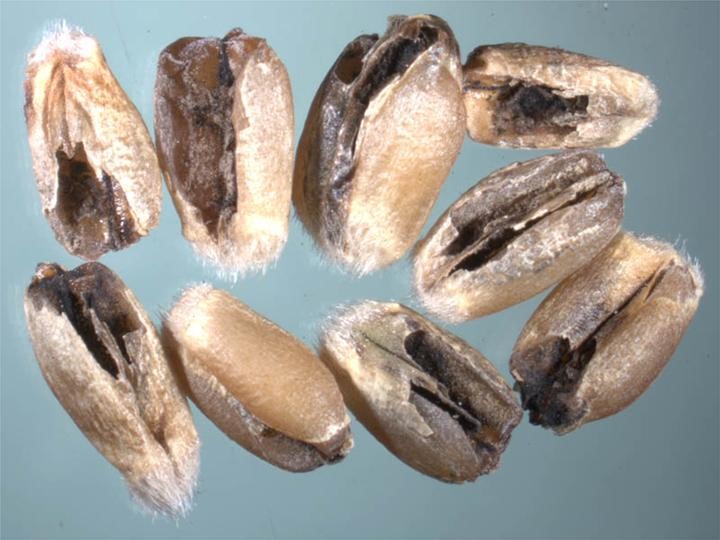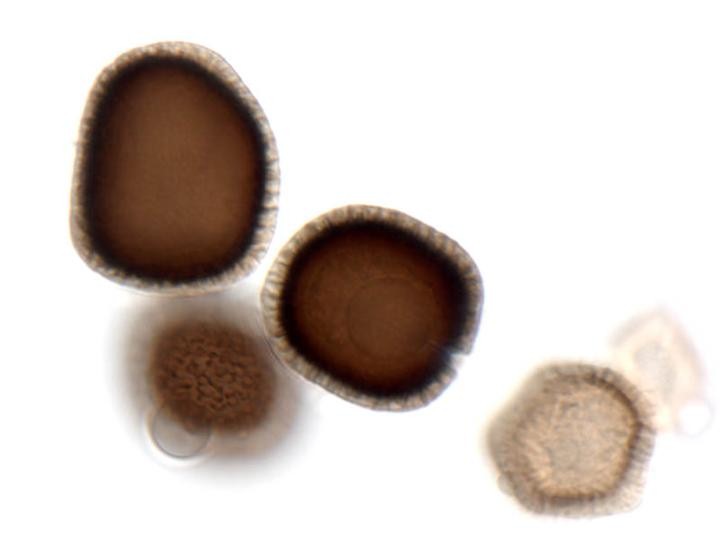Tilletia indica
Karnal Bunt
Synonyms: Neovossia indica
Class: Ustilaginomycetes
Order: Ustilaginales
Family: Tilletiaceae


Photographer: L.A. Castlebury
Source: USDA-ARS SBML
Description
Karnal bunt is caused by Tilletia indica, which is a floret-infecting smut fungus. The smut fungi get their name from the Germanic word for dirt because of the dark spores that are reproduced. Karnal Bunt is difficult to detect under field conditions because, unlike systemic smut fungi, only a few kernels of some wheat heads are infected, and usually only a portion of an infected kernel is replaced with the fungal sorus. In kernels partially infected, the sorus destroys the embryo tissue on the suture side; in advanced infection the tissues along the suture and adjacent endosperm are replaced with smut spores contained within the pericarp. Typically, only a portion of a kernel is blackened or “bunted” because it has been eroded with a mass of black spores. The spores are powdery, brownish black in mass and produce a decaying fish-like odor (trimethylamine). Point infections are most common, but infection may also spread down and, in severe cases the whole grain may be infected.
Host Plant: Wheat, durum wheat, and triticale (wheat/rye hybrid). Rye has shown to be susceptible when inoculated under laboratory conditions.
Ecological Threat: This fungus infects wheat and reduces quality and yield. Flour made from bunted kernels may be discolored and have an unpleasant odor and taste but is not a human health risk. The most detrimental effect of the disease is on international and domestic markets. Many countries will not import wheat from areas that have tested positive for the disease and some domestic flour mills will not accept it.
Biology: Wheat spiklets are susceptible from early head emergence to late anthesis. The pathogen is seedborne but is not transmitted directly from seed into plant. The teliospores of T. indica, thick walled, globose to subglobose and average 35 μm in diameter when mature. They are very resistant to adverse environmental conditions, remaining viable for 2 to 5 years in contaminated soil. Teliospores of T. indica are considered dormant immediately after formation and have poor germination up to approximately 9 months. After a period of dormancy and in the presence of moisture, teliospores at the soil surface germinate. At the time of flowering of the wheat plants, primary and secondary sporidia are presumably blown onto the surface of glumes enclosing developing wheat kernels. The sporidia on the glumes germinate and penetrate the stomates, glumes, rachis, or the ovary itself. Tilletia indica enters the newly formed kernel and develops in the intercellular space between the endosperm and seed coat. The intensity of disease establishment and development depends on environmental conditions.
History: The disease originated in India in 1931 and arrived in the United States in 1996, when it was found in Arizona and California. The following year it was found in Texas. Then a national survey was initiated over the next two years, with samples of wheat being submitted from most of the wheat producing regions of the U.S. It has been eradicated in Texas and California, but efforts to eradicate it from Arizona are continuing.
U.S. Habitat: Anywhere wheat grows is potentially threatened by Karnal Bunt
Distribution
Native Origin: First discovered in India
U.S. Present: AZ and currently eradicated from CA and TX
Resembles/Alternatives
Karnal Bunt resembles Common Bunt but that fungus typically decays the entire infected kernel.
Management
Since this fungus requires encounters on wheat spikelets between airborne secondary sporidia of different mating types; it can be prone to a decrease in genetic diversity. This can result in reduced reproductive success in smaller populations, which is beneficial for the maintenance of Karnal Bunt. Keeping infected populations small will reduce its invasive potential.
The USDA Animal and Plant Health Inspection Service (APHIS) has a quarantine against Karnal bunt to prevent the interstate spread of the disease and to protect US foreign wheat markets. Many countries have a quarantine against the introduction of Karnal bunt. USDA requires that harvest equipment be cleaned before it leaves a quarantined area.
References
Internet Sources
http://www.nda.nebraska.gov/plant/karnal_bundt.html
http://croptesting.tamu.edu/wheat/docs/mime-8.pdf
http://www.padil.gov.au/pests-and-diseases/Pest/Main/136616
http://apsjournals.apsnet.org/doi/pdf/10.1094/PDIS.1997.81.12.1370
http://www.uiweb.uidaho.edu/ag/plantdisease/kbwheat.htm#anchor6
http://wheatdoctor.cimmyt.org/index.php?option=com_content&task=view&id=97&Itemid=43
 Texas Invasive Species Institute
Texas Invasive Species Institute